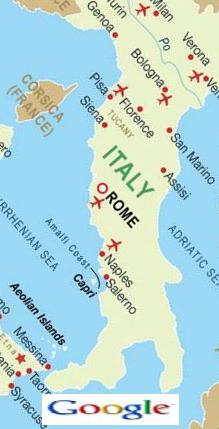Cable Moving Steadily To Advanced Advertising (DBS Has A Healthy Lead In This Race)
Feb 26, 2010 Industry News, TV and iTV Analytics

Per this story by Steve Donahue in Light Reading Cable, Canoe is setting expectations for measured, steady progress in advanced advertising via cable. Interactivity is beginning to be rolled out now, but targeting at the individual household level is 4-5 years away.
Seth Haberman of Visible World is quoted in the article as estimating that 60-70 million households will be interactive and addressable and interactive during that 4-5 year timeframe.
Between now and then, the story will be all about EBIF deployment and steady increase in the sophistication of interactive capabilities offered. EBIF households should reach upwards of 20 million households by the end of 2010. DBS operators Dish Networks and DirecTV already offer substantial interactivity in programs and advertising to 29 million households. You might be wondering what the heck EBIF is. It stands for Enhanced TV Binary Interchange Format, but really all you need to know is that it is a set of standards that will make it possible to deploy the same interactive code across all platforms that have implemented the standard. It looks like that will eventually be most Cable MSOs and IPTV providers.
What does this mean? Well, it means the long-awaited promise of TV interactivity is going to be gradually fulfilled. For programming, that means enhanced content and audience participation. For advertising, it means addressability, interactivity, and response built into ads. Finally, it means T-Commerce, which will make shopping on TV as easy and ubiquitous and easy as shopping on the web, and that will be available in programs and in ads.
The question is this: Will the internet absorb the functionality of TV (“Over-The-Top” delivery of TV programming) before TV absorbs the functionality of the Internet? We will have to wait and see. I think both will continue to exist, but will morph and mutate differently because they essentially serve different different viewer purposes and usage occasions.
The winners will be marketers and advertisers who crack the code about the right division of labor between the Internet, television, and mobile, delivering brand experiences that take advantage of the unique strengths of each available channel.
Tags: Addressability, Advanced Advertising, Cable, Cable Light Reading, DBS, EBIF, EBIF Households, Interactive Television, Interactive TV, Interactivity, Satellite TV, set-top box, Seth Haberman, T-Commerce
If Congress Thinks Cookies Violate Your Privacy, Wait’ll They Hear About This!
Feb 24, 2010 Industry News, Web Analytics

If you were to go to the Scout Analytics website dig into the info about their offerings, you’ll find that they tested their patent-pending technology for the last six months on hundreds of thousands of users (see the Press Release entitled “Scout Analytics(TM) Quantifies the Inaccuracy of Cookies as a Measure of Unique Users‘) The two techniques they cite as the basis for this study: biometric signatures and device signatures. The release is more revealing about the biometric approach than it is about the device signatures. The biometric signature is essentially an identifiable pattern in a person’s typing style. The device signature is something they are vaguer about, saying only it is based on “data elements collected from the browser to eliminate errors in device counting such as cleared cookies”. The test was meant to see not only how much overcounting of unique users there was, but how many unlicensed users there were of subscription content via multiple use of the same user account.
I wonder if they got the explicit permission of the subscribers to have their keystrokes and machines profiled? If this kind of approach were to spread beyond detection of licensing violations, I wonder how much sympathy regulators and legislators would have for it?
Tags: Behavioral Targeting, Cookies, Keystroke Profiling, licensed content, Machine Profiling, Scout Analytics, site visitor identification, unique visitors, web
Google Loses Italian Privacy Case
Feb 24, 2010 Industry News
For most of us, the recent Amanda Knox murder case was our introduction to the Italian justice system. Well, according to today’s New York Times article, several Google executives have gotten acquainted with some further nuances. For example, if you host user-generated content, you can be convicted of violating someone’s privacy if an upload to your site violates it – even if you cooperate with Italian authorities in the removal of the objectionable content and identification of the culprits.
This is a serious threat to the open sharing of information that has driven the web’s rapid adoption and growth. To force sites like YouTube to do prior filtering and checking would impose a huge burden on such sites, and could alter the viability of their business model. Worse, though, legislation purporting to protect the citizens of Italy could instead result in robbing them of free access to the web and all its unpredictable and messy usefulness. If the world ends up divided between net-freedom-haves and net-freedom-have-nots, Italy could end up on the same side of that line as China. That is not the side I’d choose to live on, no matter how good the wine and cheese are.
Tags: Google, Internet, Italy, Lawsuit, Privacy, User-generated content, YouTube
The Cookie vs. The LSO – Should I Care? Should I Worry?
Feb 18, 2010 Industry News, Web Analytics
Here’s a question that savvy web users were being asked by their parents 10 years ago:
What the heck is a cookie, and why do I have them on my computer? Do I need to delete them? How do I delete them?
Don’t be surprised if the question starts to come up again, in a new form:
What the heck is an LSO, and why do I have them on my computer? Do I need to delete them? How do I delete them?
The issue is emerging again because of the people in the business of targeting ads or offers are trying to do their job better, and cookies are not doing the job advertisers want done. So, some web programmers are exploiting a feature of Flash to create “stealth cookies” called LSOs, in hopes that you won’t delete them because you probably don’t know how.
Remind me: What is a cookie again?
A cookie is a small text file that is created via your browser to keep track of session “state” and historic entries and site activity.
What is a cookie for?
The connectionless protocols used by the web do not automatically keep track of any history. If there is no state or history information provided with a page request, then the page will have no idea who you are, even if you just entered that info on a different page in the same site.
What’s so scary about that? Well, people just don’t like their activity being recorded without their permission or awareness. It annoys them. That said, there are useful things that this kind of snooping makes possible:
At the same time, it makes possible:
Cookie Deletion
When many people figured all this out it became a big kerfuffle, and this led to user behavior such that 23% of all cookies are deleted when they are one week old, and that less than half of all cookies (43%) live to be more than eight weeks old (click here to see Microsoft research about cookie deletion). Users can use functionality in their browsers to delete cookies and to control cookie-related policies within the browser.
So who cares? What problems does cookie deletion cause?
If you are an internet advertiser, it adds one more layer of complexity to the already difficult problem of tracking internet ad campaigns. You’ll have tracking pixels in ads to capture views and clicks, but knowing how many times someone has seen an ad during a campaign (frequency) and how many distinct individuals have seen an ad (reach) is pretty critical to understanding what is going on in a campaign, especially as more brand advertising comes online. Measurement is made difficult in internet advertising by these factors:
Net/Net: Bad Measurements
On balance, these issues push the measurements in the direction of overcounting reach and undercounting frequency.
Some of the other deficiencies of cookies from an advertiser point of view are that cookies don’t store very much information (4KB), and there can only be so many cookies related to a given domain (20). Privacy considerations additionally limit how much cross-site behavior can be captured in cookies (and banner campaigns are cross-site, mostly).
LSOs Addess Some of These Shortcomings For Advertisers (Yay!), But Create New Ones for Users (Boo!)
An LSO (Local Storage Object) is a cookie-like file that Flash uses to store information for Flash applications. Except that they are used by clever web programmers for far more than that – they are used by some sites just like really big cookies (as much as 25 times bigger than a cookie) that you don’t know about and so won’t delete. In addition, the same LSOs are accessible from all browsers. Your browser security controls have little or no impact on these things.
You Might Want To Check Your Computer For LSOs Right Now
If you don’t believe me, go to the Macromedia page that lets you see what LSOs are on your machine (it also lets you delete them, enable/disable them, and control their behavior).
It is located here: http://www.macromedia.com/support/documentation/en/flashplayer/help/settings_manager07.html.
While you are there, delete the ones for sites you don’t want your boss to know about.
As for where this is all going, all privacy loopholes on the web are temporary, and there are already browser add-ins that let you control and delete LSOs, and at some point the browsers will absorb that functionality to make it easy for you to use. If I were you, I’d worry more about the things you can’t see: The new keystroke dynamics technique for identifying users announced by Scout Analytics (here) and backend ISP- and CDN- based tracking – all these are fodder for more paranoid posts in the future.
Tags: Analytics, banners, Campaign Analytics, Cookies, Flash Cookies, frequency, Internet Advertising, LSOs, marketing, Media Measurement, Privacy, reach, Security
Opening Weekend for 2010 Winter Olympics: 117 Million US Viewers
Feb 16, 2010 Industry News, TV and iTV Analytics
Check out this article by Robert Seidman on TVbytheNumbers.com In it, he cites Nielsen ratings indicating this year’s opening ceremonies beat the Torino Olympics’ opening weekend by 5 million viewers. The average of 28.6 million viewers over the first weekend beat Torino’s first weekend by 25%.
This beats the 106.5 million viewers last weekend for the Super Bowl (see the prior post in this blog), but that was much more concentrated in time. The Super Bowl got a 68 share while the Olympics first weekend got a 26.
The Olympics also did well on the smaller screens. Three Olympics apps are currently in the top 10 on iTunes, and NBCOlympics.com traffic is 250% higher than it was for Torino. It has only been a few days, but there have already been more unique viewers for NBCOlympics.com during the Vancouver Olympics than than there were for the whole Torino Olympics.
Play With Your TV! (a shameless plug for my #1 client, Ensequence)
If you are watching the Olympics via Dish Networks or Verizon FiOS, then you can access weblike interactive content right on your TV screen alongside your favorite Olympics events. Once you tune to MSNBC, CNBC, or USA, a prompt will pop up (nothing on NBC itself, as far as I know). Clicking the “Select” button on your remote starts an interactive experience that includes Top Stories, Medal Counts, Athlete Bios, and more. Real interactive TV in the wild. Check it out!
Tags: Analytics, audience, Bill Seely, Ensequence, Inteactive Television, Interactive TV, Metrics, Nielsen, Olympics, Olympics Interactive, Practical Marketing Analytics, Robert Seidman, TV and iTV Analytics, TV Ratings, TV Viewers, Viewership
Nielsen Estimates 106.5 Million Viewers for Super Bowl XLIV (aka Beating the Pants Off Elvis)
Feb 8, 2010 Industry News, TV and iTV Analytics
In a story by David Bauder of the Associated Press, A.C. Nielsen went on record estimating that 106.5 million viewers watched Super Bowl XLIV (see at WashingtonPost.com HERE). That is the most heavily viewed event in TV history, bigger than (according to Wikipedia):
– the final episode of M*A*S*H (105.97 million viewers)
– last year’s Super Bowl (98.7 million viewers)
– the Beatles’ first appearance on The Ed Sullivan Show (73 million viewers)
– Elvis’ first appearance on The Ed Sullivan Show (60 million viewers)
To be fair to the shows of yesteryear, the total US population (and the number of households having TVs) has continued to increase since those days. There are about 305 million people currently living in the US, so about 1/3 of the entire population watched the game.
It is remarkable in our modern splinter group society that we could find something that such a huge group of people could watch together, especially when you could rule so many people out right at the starting gate: infants, toddlers, anyone in solitary confinement, anyone unconscious or too sick to care, anyone at work in a job where you can’t watch TV while you work, almost anyone who was in an airplane at the time, and most people who immigrated from countries where a “football” is something spherical.
I don’t know the full importance of this number, but it does suggest that:
1. TV has not been made irrelevant by the Internet, despite Internet entrepreneurs’ claims
2. People will still show up in giant hordes to watch a TV event en masse, if the product they are watching is enticing enough
3. Ed Sullivan really blew it by making them shoot Elvis from the waist up. The least remarkable half of him got 60 million viewers. Who knows what the full Elvis could have scored?
Tags: Analytics, AP, Associated Press, Bill Seely, David Bauder, Elvis Presley, Highest-Viewed TV Show, M*A*S*H, Metrics, Nielsen, Practical Marketing Analytics, Super Bowl, TV Viewers



